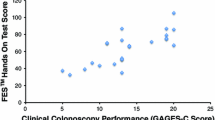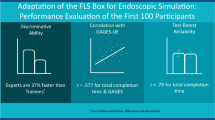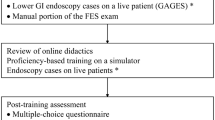Abstract
Background
Simulators may improve the efficiency, safety, and quality of endoscopic training. However, no objective, reliable, and valid tool exists to assess clinical endoscopic skills. Such a tool to measure the outcomes of educational strategies is a necessity. This multicenter, multidisciplinary trial aimed to develop instruments for evaluating basic flexible endoscopic skills and to demonstrate their reliability and validity.
Methods
The Global Assessment of Gastrointestinal Endoscopic Skills (GAGES) Upper Endoscopy (GAGES-UE) and Colonoscopy (GAGES-C) are rating scales developed by expert endoscopists. The GAGES scale was completed by the attending endoscopist (A) and an observer (O) in self-assessment (S) during procedures to establish interrater reliability (IRR, using the intraclass correlation coefficient [ICC]) and internal consistency (IC, using Cronbach’s alpha). Instrumentation was evaluated when possible and correlated with total scores. Construct and external validity were examined by comparing novice (NOV) and experienced (EXP) endoscopists (Student’s t-test). Correlations were calculated for GAGES-UE and GAGES-C with participants who had performed both.
Results
For the 139 completed evaluations (60 NOV, 79 EXP), IRR (A vs. O) was 0.96 for GAGES-UE and 0.97 for GAGES-C. The IRR between S and A was 0.78 for GAGES-UE and 0.89 for GAGES-C. The IC was 0.89 for GAGES-UE, and 0.95 for GAGES-C. There were mean differences between the NOV and the EXP endoscopists for GAGE-UE (14.4 ± 3.7 vs. 18.5 ± 1.6; p < 0.001) and GAGE-C (11.8 ± 3.8 vs. 18.8 ± 1.3; p < 0.001). Good correlation was found between the scores for the GAGE-UE and the GAGE-C (r = 0.75; n = 37). Instrumentation, when performed, demonstrated correlations with total scores of 0.84 (GAGE-UE; n = 73) and 0.86 (GAGE-C; n = 45).
Conclusions
The GAGES-UE and GAGES-C are easy to administer and consistent and meet high standards of reliability and validity. They can be used to measure the effectiveness of simulator training and to provide specific feedback. The GAGES results can be generalized to North American and European endoscopists and may contribute to the definition of technical proficiency in endoscopy.


Similar content being viewed by others
References
Bittner JG IV, Marks JM, Dunkin BJ, Richards WO, Onders RP, Mellinger JD (2007) Resident training in flexible gastrointestinal endoscopy: a review of current issues and options. J Surg Educ 64:399–409
American Society for Gastrointestinal Endoscopy (2002) Methods of granting hospital privileges to perform gastrointestinal endoscopy. Gastrointest Endosc 55:780–783
MacSween HM (1997) Canadian Association of Gastroenterology Practice Guideline for granting of privileges to perform gastrointestinal endoscopy. Can J Gastroenterol 11:429–432
American Board of Colon and Rectal Surgery (2008) Operative procedures standards policy. http://www.abcrs.org/default.htm. Retrieved 15 April 2009
Society of American Gastrointestinal and Endoscopic Surgeons (1998) Granting privileges for gastroinestinal endoscopy by surgeons. Surg Endosc 12:381–382
Eisen GM, Baron TH, Dominitz JA, Faigel DO, Goldstein JL, Johanson JF, Mallery JS, Raddawi HM, Vargo JJ II, Waring JP, Fanelli RD, Wheeler-Harbough J (2002) Methods of granting hospital privileges to perform gastrointestinal endoscopy. Gastrointest Endosc 55:780–783
Bell RH (2007) Surgical council on resident education: a new organization devoted to graduate surgical education. J Am Coll Surg 204:341–346
Cohen J, Cohen SA, Vora KC, Xue X, Burdick JS, Bank S, Bini EJ, Bodenheimer H, Cerulli M, Gerdes H, Greenwald D, Gress F, Grosman I, Hawes R, Mullin G, Schnoll-Sussman F, Starpoli A, Stevens P, Tenner S, Villanueva G (2006) Multicenter, randomized, controlled trial of virtual reality simulator training in acquisition of competency in colonoscopy. Gastrointest Endosc 64:361–368
Cass OW, Freeman ML, Peine CJ, Zera RT, Onstad GR (1993) Objective evaluation of endoscopy skills during training. Ann Intern Med 118:40–44
Chak A, Cooper GS, Blades EW, Canto M, Sivak MV Jr (1996) Prospective assessment of colonoscopic intubation skills in trainees. Gastrointest Endosc 44:54–57
Gerson LB, Van Dam J (2003) A prospective randomized trial comparing a virtual reality simulator to bedside teaching for training in sigmoidoscopy. Endoscopy 35:569–575
Accredication Council for Graduate Medical Education (2006) Memorandum regarding changes in minimum requirements for laparoscopy and endoscopy. www.acgme.org/acWebsite/RRC_440/440_minReqLaparoscopy.as. Accessed 14 April 2009
Cass O, Freeman M, Cohen J, Zuckerman G, Fennerty M, Randall G, Jensen D, Nord J, Cerulli M, Etzkorn K (1995) Acquisition of competency in endoscopic skills (ACES) during training: early results of a multicenter study. Gastrointest Endosc 41:317
Wexner SD, Garbus JE, Singh JJ (2001) A prospective analysis of 13,580 colonoscopies: reevaluation of credentialing guidelines. Surg Endosc 15:251–261
Reed WP, Kilkenny JW, Dias CE, Wexner SD (2004) A prospective analysis of 3,525 esophagogastroduodenoscopies performed by surgeons. Surg Endosc 18:11–21
Marks JM, Nussbaum MS, Pritts TA, Scheeres DE (2001) Evaluation of endoscopic and laparoscopic training practices in surgical residency programs. Surg Endosc 15:1011–1015
Bar-Meir S (2000) A new endoscopic simulator. Endoscopy 32:898–900
Clark JA, Volchok JA, Hazey JW, Sadighi PJ, Fanelli RD (2005) Initial experience using an endoscopic simulator to train surgical residents in flexible endoscopy in a community medical center residency program. Curr Surg 62:59–63
Eversbusch A, Grantcharov TP (2004) Learning curves and impact of psychomotor training on performance in simulated colonoscopy: a randomized trial using a virtual reality endoscopy trainer. Surg Endosc 18:1514–1518
Felsher JJ, Olesevich M, Farres H, Rosen M, Fanning A, Dunkin BJ, Marks JM (2005) Validation of a flexible endoscopy simulator. Am J Surg 189:497–500
Koch AD, Buzink SN, Heemskerk J, Botden SM, Veenendaal R, Jakimowicz JJ, Schoon EJ (2008) Expert and construct validity of the Simbionix GI Mentor II endoscopy simulator for colonoscopy. Surg Endosc 22:158–162
Ferlitsch A, Glauninger P, Gupper A, Schillinger M, Haefner M, Gangl A, Schoefl R (2002) Evaluation of a virtual endoscopy simulator for training in gastrointestinal endoscopy. Endoscopy 34:698–702
Moorthy K, Munz Y, Jiwanji M, Bann S, Chang A, Darzi A (2004) Validity and reliability of a virtual reality upper gastrointestinal simulator and cross validation using structured assessment of individual performance with video playback. Surg Endosc 18:328–333
Ritter EM, McClusky DA 3rd, Lederman AB, Gallagher AG, Smith CD (2003) Objective psychomotor skills assessment of experienced and novice flexible endoscopists with a virtual reality simulator. J Gastrointest Surg 7:871–877; discussion 877–878
Sedlack RE, Kolars JC (2002) Colonoscopy curriculum development and performance-based assessment criteria on a computer-based endoscopy simulator. Acad Med 77:750–751
Sedlack RE, Kolars JC (2004) Computer simulator training enhances the competency of gastroenterology fellows at colonoscopy: results of a pilot study. Am J Gastroenterol 99:33–37
Adamsen S, Funch-Jensen PM, Drewes AM, Rosenberg J, Grantcharov TP (2005) A comparative study of skills in virtual laparoscopy and endoscopy. Surg Endosc 19:229–234
Datta V, Mandalia M, Mackay S, Darzi A (2002) The PreOp flexible sigmoidoscopy trainer: validation and early evaluation of a virtual reality based system. Surg Endosc 16:1459–1463
Mahmood T, Darzi A (2003) A study to validate the colonoscopy simulator. Surg Endosc 17:1583–1589
Fried GM, Feldman LS, Vassiliou MC, Fraser SA, Stanbridge D, Ghitulescu G, Andrew CG (2004) Proving the value of simulation in laparoscopic surgery. Ann Surg 240:518–525; discussion 525–518
Peters JH, Fried GM, Swanstrom LL, Soper NJ, Sillin LF, Schirmer B, Hoffman K (2004) Development and validation of a comprehensive program of education and assessment of the basic fundamentals of laparoscopic surgery. Surgery 135:21–27
Swanstrom LL, Fried GM, Hoffman KI, Soper NJ (2006) Beta test results of a new system assessing competence in laparoscopic surgery. J Am Coll Surg 202:62–69
McCluney AL, Vassiliou MC, Kaneva PA, Cao J, Stanbridge DD, Feldman LS, Fried GM (2007) FLS simulator performance predicts intraoperative laparoscopic skill. Surg Endosc 21:1991–1995
Martin JA, Regehr G, Reznick R, MacRae H, Murnaghan J, Hutchison C, Brown M (1997) Objective structured assessment of technical skill (OSATS) for surgical residents. Br J Surg 84:273–278
Reznick R, Regehr G, MacRae H, Martin J, McCulloch W (1997) Testing technical skill via an innovative “bench station” examination. Am J Surg 173:226–230
Vassiliou MC, Feldman LS, Andrew CG, Bergman S, Leffondre K, Stanbridge D, Fried GM (2005) A global assessment tool for evaluation of intraoperative laparoscopic skills. Am J Surg 190:107–113
Freeman ML, Nelson DB, Sherman S, Haber GB, Herman ME, Dorsher PJ, Moore JP, Fennerty MB, Ryan ME, Shaw MJ, Lande JD, Pheley AM (1996) Complications of endoscopic biliary sphincterotomy. N Engl J Med 335:909–918
Campbell DT, Fiske DW (1959) Convergent and discriminant validation by the multitrait-multimethod matrix. Psychol Bull 56:81–105
Acknowledgments
We acknowledge all the members of the FES taskforce for their participation in this research. We also thank Lisa Jukelevics, Carla Bryant, and Sarah Colon for their help and support in bringing this project forward. Given the limited number of authors that could be included, we also acknowledge all the contributors from the different institutions that made this study possible. This project was supported in part by SAGES and the Fundamentals of Endoscopic Surgery Task Force.
Disclosures
Melina C. Vassiliou, Pepa A. Kaneva, Benjamin K. Poulose, Brian J. Dunkin, Jeffrey M. Marks, Riadh Sadik, Gideon Sroka, Mehran Anvari, Klaus Thaler, Gina L. Adrales, Jeffrey W. Hazey, Jenifer R. Lightdale, Vic Velanovich, Lee L. Swanstrom, John D. Mellinger, and Gerald M. Fried have no conflicts of interest or financial ties relevant to this report to disclose.
Author information
Authors and Affiliations
Corresponding author
Rights and permissions
About this article
Cite this article
Vassiliou, M.C., Kaneva, P.A., Poulose, B.K. et al. Global Assessment of Gastrointestinal Endoscopic Skills (GAGES): a valid measurement tool for technical skills in flexible endoscopy. Surg Endosc 24, 1834–1841 (2010). https://doi.org/10.1007/s00464-010-0882-8
Received:
Accepted:
Published:
Issue Date:
DOI: https://doi.org/10.1007/s00464-010-0882-8




